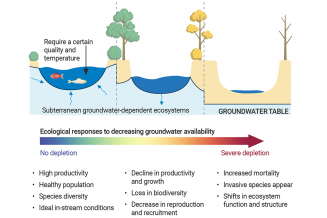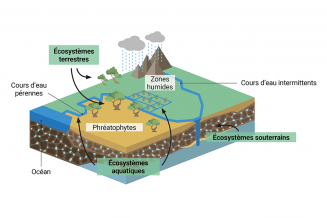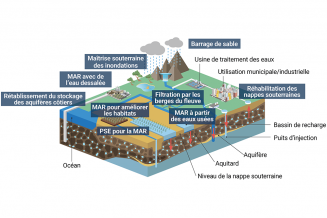Ecosystems

Groundwater-dependent ecosystems (GDEs) can be found across a variety of landscapes, ranging from high mountain valleys to the bottom of the ocean and even deserts. They consist of plants, animals and fungi that rely on groundwater flow, temperature or chemical characteristics. Groundwater discharge supports the baseflows of streams and rivers, a crucial water source that determines their risk of falling dry during periods of drought.
GDEs play critical roles in protecting aquifers from contamination by ensuring physical separation, by enabling biophysical processes like filtration, biodegradation, and by facilitating and protecting natural recharge.
For example, in more humid areas, riparian forests and wetlands can purify nitrogen-rich runoff and drainage from agricultural and livestock farming activities, reducing the nutrient loading in GDEs. Conversely, in more arid areas, seasonal flooding may enhance groundwater recharge in floodplains, while sedimentation may provide significant nutrient and soil-improving amendments.
Groundwater-dependent ecosystems and the related ecosystem services (i.e. storing and providing water resources, attenuating contaminants, and controlling disease) are currently threatened by groundwater depletion, climate change and land use changes.
Climate change has a big impact on GDEs, since groundwater often acts as a buffer during drought, either naturally through feeding streams in dry periods, or indirectly through increased human use during such periods.
There is a significant drying of springs, wetlands and oases around the world. Hotspots of groundwater depletion are found around the world, often in regions with intensive groundwater withdrawals for irrigation. The persistent decline in water levels, influences both aquatic and terrestrial ecosystems.
Land use changes also affect GDEs. For example, the loss of dry forests has led to regional salinization some regions of the world (Australia and the Chaco region of Argentina and Paraguay).
Ecological impacts of decreasing groundwater quality and quantity
Even though groundwater discharge and baseflow are the basis for the good state of many aquatic ecosystems, these systems are not considered by groundwater management that focuses mainly on aquifers.
GDEs, especially terrestrial and subterranean, are usually not directly or formally protected. An important exception to this is the Ramsar Convention, which developed a seven-step groundwater management framework to maintain the ecological character of wetlands of international importance.
Groundwater is part of both the water cycle and complex aquatic, terrestrial and subterranean ecosystems. It is thus essential to integrate groundwater management with ecosystem and watershed protection to ensure the well-being of groundwater-dependent ecosystems.












